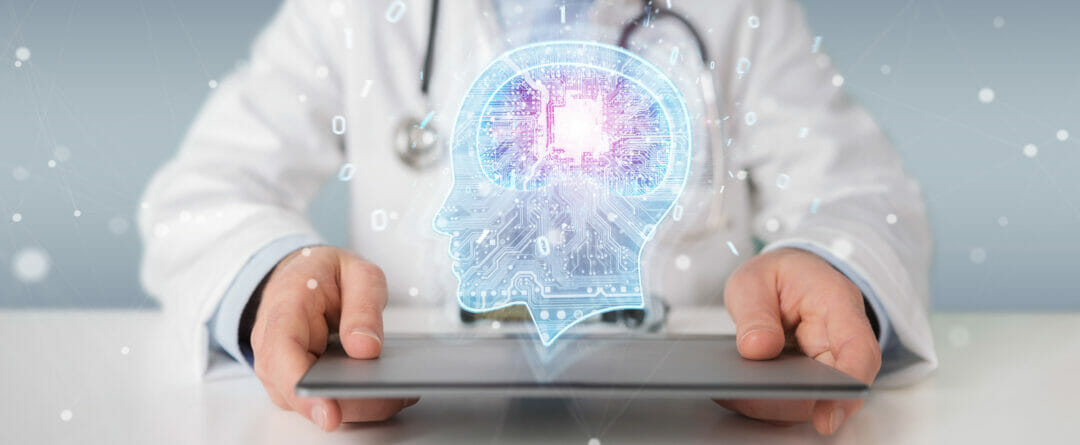As we approach one year since the first national lockdown in the UK, it is clear that Covid-19 is still putting enormous pressures on our healthcare system. Indeed, the NHS reported in January that a record 4.46 million people were on the waiting list for routine treatments and operations, and a recent study by the British Medical Association found that almost 60% of doctors are suffering from some form of anxiety or depression. The path to recovering from this healthcare fallout will not be easy, however, when thinking about how we could alleviate this pressure in the future, emerging artificial intelligence (AI) technologies may be the answer.
Alleviating the pressures on doctors and nurses
The World Health Organisation (WHO) predicts that there will be a shortfall of around 9.9 million healthcare professionals worldwide by 2030, despite the economy being able to create 40 million new health sector jobs by the same year. With larger, aging populations and increasingly complex healthcare demands, there will continue to be strain on health workers for the foreseeable future – so how can AI alleviate this?
The UK government is already working to boost its adoption of advanced technologies in healthcare through the NHS Long Term Plan. The focus of the plan is to speed up diagnosis, reduce administrative pressures, and improve outpatient services – and we’re already seeing some great innovations in this space.
Indeed, Addenbrooke’s Hospital in Cambridge is working with Microsoft to deploy innovative AI tools that can quickly review 3D scans of a patient’s organs and highlight potential tumors. Critically Microsoft’s InnerEye technology can review and highlight scans thirteen times faster than current methods, meaning doctors and patients get the results they need more quickly. Similarly, Moorfields Eye Hospital in London collaborated with artificial intelligence company DeepMind to develop an AI system that could quickly detect eye disease and correctly recommend treatments with unprecedented accuracy and speed, helping doctors deliver essential therapies faster.
On the administrative front, the US-based Brookings Institutions estimated in 2019 that around 33% of tasks performed by healthcare practitioners, such as admissions documentation and patient-case summaries, have the potential to be automated. This would help doctors and nurses reallocate their time to meet demand – an area that is also being addressed through the use of AI. Excitingly, in April last year, four acute hospitals across England piloted the Covid-19 Capacity Planning and System (CPAS) – a machine learning system that predicted demand for ICU beds and ventilators. This tool helped hospital systems balance workforce planning against day-to-day care to ensure the hospitals were not overwhelmed. Looking forward, tools like CPAS could be connected with outpatient and community services to help hospitals predict surges in demand (around flu season, for example) and prepare accordingly.
AI use cases in healthcare for Covid-19 and beyond
Empowering individuals to manage their healthcare
With growing, aging populations, there will have to be a shift away from hospitals to more home-based, community-led care models in order to meet demand. AI will play a critical role in this shift, supporting individuals to manage their own health and wellbeing. This is a really exciting field, and there are some fantastic examples out there to take inspiration from.
Back in 2019, Reason Digital partnered with Parkinson’s UK, the Stroke Association, Muscular Dystrophy UK and the MS Society to develop an AI tool that would support people with chronic conditions. The Digital Health Assistant (DHA) uses machine learning to understand and adapt to a person’s needs over time based on interactions. It can give targeted support on things such as medication and diet, appointments and updates, as well as managing symptoms. Tools like Amazon’s Alexa or the Google Nest also have a host of features which can help people navigate their health conditions, such as setting reminders for routine medications and appointments or describing accurate symptoms for conditions. Alexa also has some impressive functionality to track blood glucose levels and access post-surgical care instructions and Amazon is always adding new ‘skills’ to the Alexa Skill Kit. Indeed, the British Red Cross have a free Alexa skill that provides first aid advice for minor ailments or more serious conditions, until professional help arrives.
Promisingly, the future of tools like this may not only be in the management of conditions, but also the detection. In 2019, researchers at the University of Washington published a study where they trained Alexa and two other devices to listen for ‘agonal breathing’ – that is, the gasping sounds that are usually an early warning sign that someone is having a cardiac arrest. The devices correctly identified agonal breathing in 97% of instances, while registering a false positive in only 0.2% of cases. Elsewhere in the US, AI is being used to detect when an elderly person has fallen over. AltumView’s Cypress Smart Home Care Alert System is a fall prevention sensor that monitors movements within an individual’s house and can detect emergencies such as falls, waving for help, and wanderings, which are particularly common among patients with dementia. Where there is an incident, this is recorded in real-time using an app that can be accessed by medical professionals and family members so that the individual gets the help they need quickly.
Trend Micro reveals biggest cloud challenges for healthcare organisations
Revolutionising the way we discover and accelerate treatments
The Covid-19 pandemic shone a light on the pitfalls of traditional drug discovery methods, as pressure increased on countries to develop and approve treatments for the virus. Traditionally, to bring a new drug to market takes 10-14 years, costs between $2-3 billion, and has a 95% failure rate. But with the use of AI technology, both time and risk can be reduced. Earlier last year, Japanese startup Elix used its AI platform to rapidly screen a library of 350 million drug-like molecules to find potential drugs to treat Covid-19. One of the possible candidates identified was remdevisir, which recently received emergency use authorisation from the US Food and Drug Administration (FDA) to treat Covid-19 patients.
Looking beyond the pandemic, AI has the potential to completely revolutionise drug discovery. The technology is being used to quickly find novel treatments for patients with rare diseases. Currently, we believe there are 7,000 known rare conditions that affect around 400 million people globally, but only 5% of those have approved medications. Finding drug combinations from nine million possible pairings is not easy, but AI can accelerate this by analysing data much faster than a human team could. It then synthesises potential connections at lightning speed, enabling teams to predict (and eventually bring to market) treatments for a greater number of rare disease patients who have previously been locked out of innovations in the drug discovery field.
Unlocking future uses for AI
As technological advances become more innovative, it is clear that the possible use cases of AI in healthcare are endless. Two areas I am particularly excited by are the use of autonomous vehicles and virtual reality (VR) tools to support healthcare delivery.
VR — the most needed proptech solution in a post-Covid world
2020 was the year where self-driving vehicle companies like Nuro saw their AI being trialed to make deliveries for retail giants like CVS and Kroger. But in the future, I believe that autonomous vehicles won’t just be limited to food deliveries, but will also include prescription and medicine drop-offs. These autonomous pharmaceutical deliveries will reduce waiting times for patients, widen access to medication to under-served populations, and alleviate pressure on pharmacists by operating an efficient door-to-door service.
AI could also be deployed further within the realm of virtual reality imaging. Surgical simulators that combine VR and haptics are already in use across the globe, but with the volume of new procedures and information ever increasing, surgical VR could help lower costs, risk, and time spent learning how to use new tools or perform new operations. Adopting a VR simulator also means that trained medical professionals could spend less time teaching and more time caring for patients in need.
Navigating the disruption caused by the pandemic will be a challenge for the healthcare sector for many years to come. But as we look forward, we should take courage in the many innovations that have been developed to not only address Covid-19 but also alleviate other pressures on the healthcare system as well. It has been heartening to see researchers, scientists and doctors collaborate to bring much-needed technology to the NHS and beyond, and as we recover from the pandemic, we must continue to develop and invest in AI technologies to ensure that doctors, nurses and patients get the support they need.











